Drinking Behaviour of Beef Cattle Subject to Water Medication in Various Environmental Conditions
Abstract
1. Introduction
2. Materials and Methods
2.1. Experiment 1
2.2. Experiment 2
2.3. Chemical Analyses
2.4. Weather Variables Calculations
2.5. Statistical Analysis
3. Results
3.1. Experiment 1
3.2. Experiment 2
4. Discussion
5. Conclusions
Supplementary Materials
Author Contributions
Funding
Institutional Review Board Statement
Data Availability Statement
Acknowledgments
Conflicts of Interest
References
- Beede, D.K. What will our ruminants drink? Anim. Front. 2012, 2, 36–43. [Google Scholar] [CrossRef]
- Yoshihara, Y.; Tada, C.; Takada, M.; Purevdorj, N.-O.; Chimedtseren, K.; Nakai, Y. Effects of water source on health and performance of Mongolian free-grazing lambs. Small Rumin. Res. 2016, 137, 81–84. [Google Scholar] [CrossRef]
- Utley, P.R.; Bradley, N.W.; Boling, J.A. Effect of restricted water intake on feed intake, nutrient digestibility and nitrogen metabolism in steers. J. Anim. Sci. 1970, 31, 130–135. [Google Scholar] [CrossRef] [PubMed]
- National Research Council. Nutrient Requirements of Small Ruminants: Sheep, Goats, Cervids, and New World Camelids; NRC: Washington, DC, USA, 2007; 384p. [Google Scholar]
- SCA. Feeding Standards for Australian Livestock: Ruminants; CSIRO Publishing: Clayton, Australia, 1994; 266p. [Google Scholar]
- Beed, D.K. Solving bad water problems for thirsty cows. In Proceedings of the Western Dairy Management Conference, Reno, NV, USA, 19 January 2009; Available online: http://wdmc.org/2009/Solving%20Bad%20Water%20Problems%20for%20Thirsty%20Cows (accessed on 9 January 2024).
- National Health and Medical Research Council. Any Use of Animals for Scientific Purposes Must Be Ethical, Humane and Responsible; Butterworths Pty Limited: Sydney, NSW, Australia, 2021. Available online: https://www.nhmrc.gov.au/about-us/publications/australian-code-care-and-use-animals-scientific-purposes (accessed on 1 September 2023).
- CiboLabs. Building Solutions for Agriculture. Available online: https://www.cibolabs.com.au/ (accessed on 27 December 2023).
- Coimbra, P.A.D.; Machado Filho, L.C.P.; Nunes, P.A.; Hötzel, M.J.; de Oliveira, A.G.L.; Cecato, U. Effect of water trough type on the drinking behaviour of pasture-based beef heifers. Animal 2010, 4, 116–121. [Google Scholar] [CrossRef] [PubMed]
- BOM. Average Annual, Seasonal and Monthly Rainfall. Available online: http://www.bom.gov.au/climate/dwo/IDCJDW4100.latest.shtml (accessed on 28 December 2023).
- Linacre, E.T. A simple formula for estimating evaporation rates in various climates using temperature data alone. Agric. Meteorol. 1977, 8, 409–424. [Google Scholar] [CrossRef]
- Copley, J.P.; Engle, B.N.; Ross, E.M.; Speight, S.; Fordyce, G.; Wood, B.J.; Voss-Fels, K.P.; Hayes, B.J. Environmental variation effects fertility in tropical beef cattle. Transl. Anim. Sci. 2022, 6, txac035. [Google Scholar] [CrossRef] [PubMed]
- RStudio. Team RStudio: Integrated Development Environment for R. 2023. Available online: https://www.rstudio.com/categories/integrated-development-environment/ (accessed on 28 December 2023).
- Lardner, H.A.; Braul, L.; Schwartzkopf-Genswein, K.; Schwean-Lardner, K.; Damiran, D.; Darambazar, E. Consumption and drinking behavior of beef cattle offered a choice of several water types. Livest. Sci. 2013, 157, 577–585. [Google Scholar] [CrossRef]
- McLennan, S.R.; Hirst, D.J.; Shepherd, R.K.; McGuigan, K.R. A comparison of various methods of feeding supplements of urea, sulfur and molasses to weaner heifers during the dry season in northern Queensland. Aust. J. Exp. Agric. 1991, 31, 153–158. [Google Scholar] [CrossRef]
- Sheffield, R.E.; Mostaghimi, S.; Vaughan, D.H.; Collins, E.R., Jr.; Allen, V.G. Off-stream water sources for grazing cattle as a stream bank stabilization and water quality BMP. Trans. ASAE 1997, 40, 595–604. [Google Scholar] [CrossRef]
- Yeates, N.T.M.; Schmidt, P.J. Beef Cattle Production; Butterworths Pty Limited: Sydney, NSW, Australia, 1974; 323p. [Google Scholar]
- Rouda, R.R.; Andersson, D.M.; Wallace, J.D.; Murray, L.W. Free-ranging cattle water-consumption in south-central New-Mexico. Appl. Anim. Behav. Sci. 1994, 39, 29–38. [Google Scholar] [CrossRef]
- Meyer, U.; Everinghoff, M.; Gadeken, D.; Flachowsky, G. Investigations on the water intake of lactating dairy cows. Livest. Prod. Sci. 2004, 90, 117–121. [Google Scholar] [CrossRef]
- Loneragan, G.H.; Wagner, J.J.; Gould, D.H.; Garry, F.B.; Thoren, M.A. Effects of water sulfate concentration on performance, water intake and carcass characteristics of feedlot steers. J. Anim. Sci. 2001, 79, 2941–2948. [Google Scholar] [CrossRef] [PubMed]
- Meyer, U.; Stahl, W.; Flachowsky, G. Investigations on the water intake of growing bulls. Livest. Sci. 2006, 103, 186–191. [Google Scholar] [CrossRef]
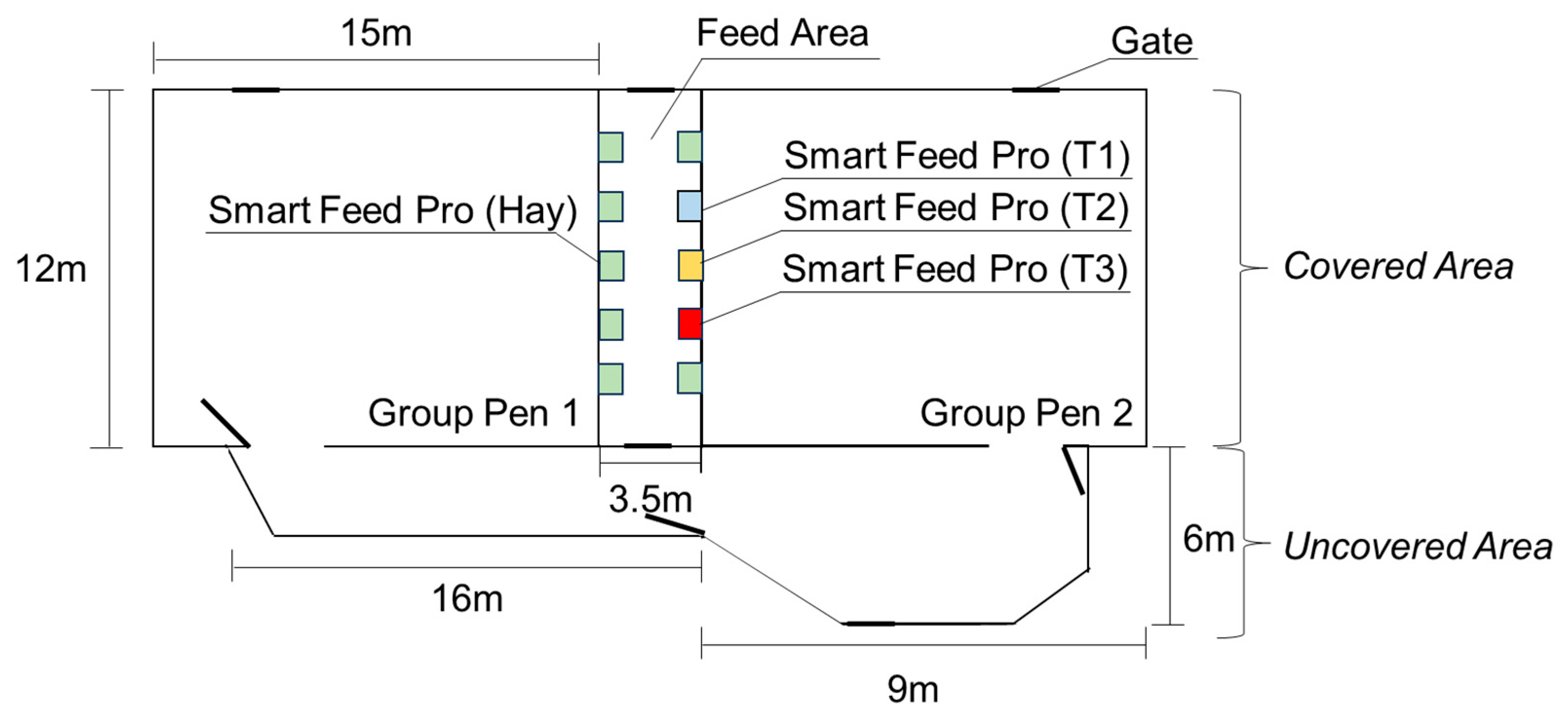
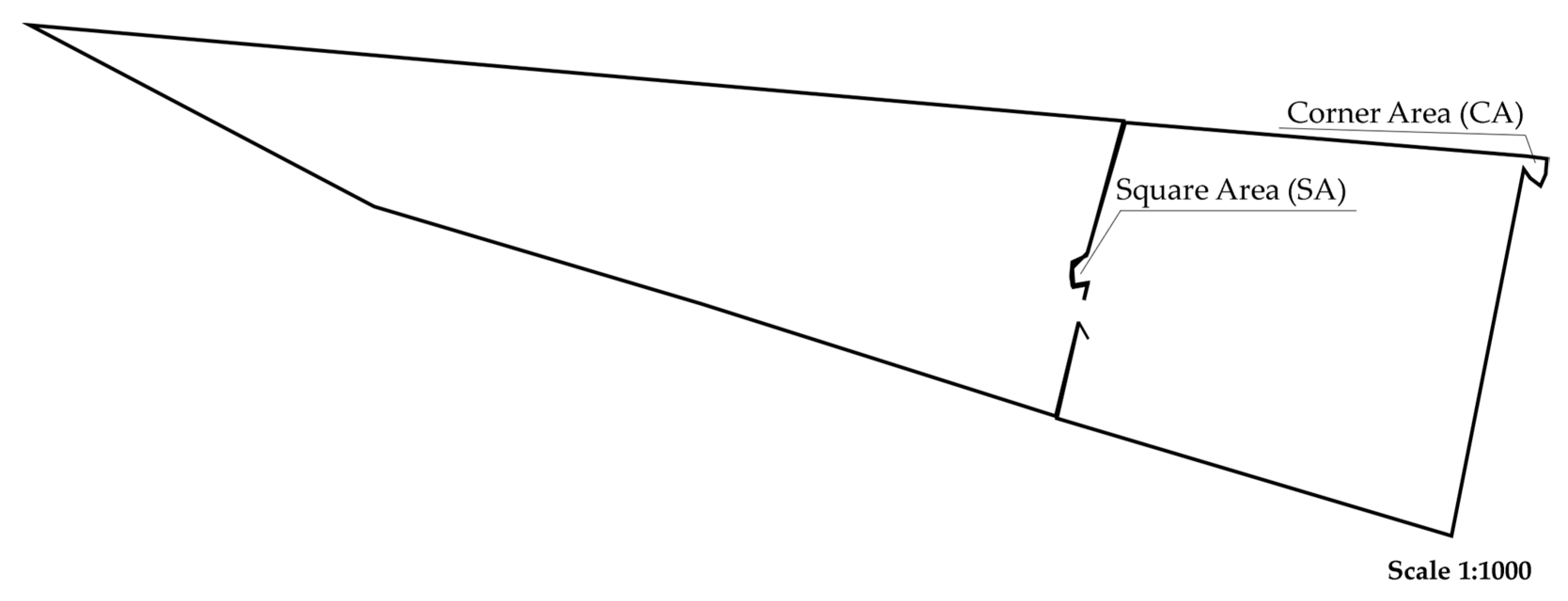
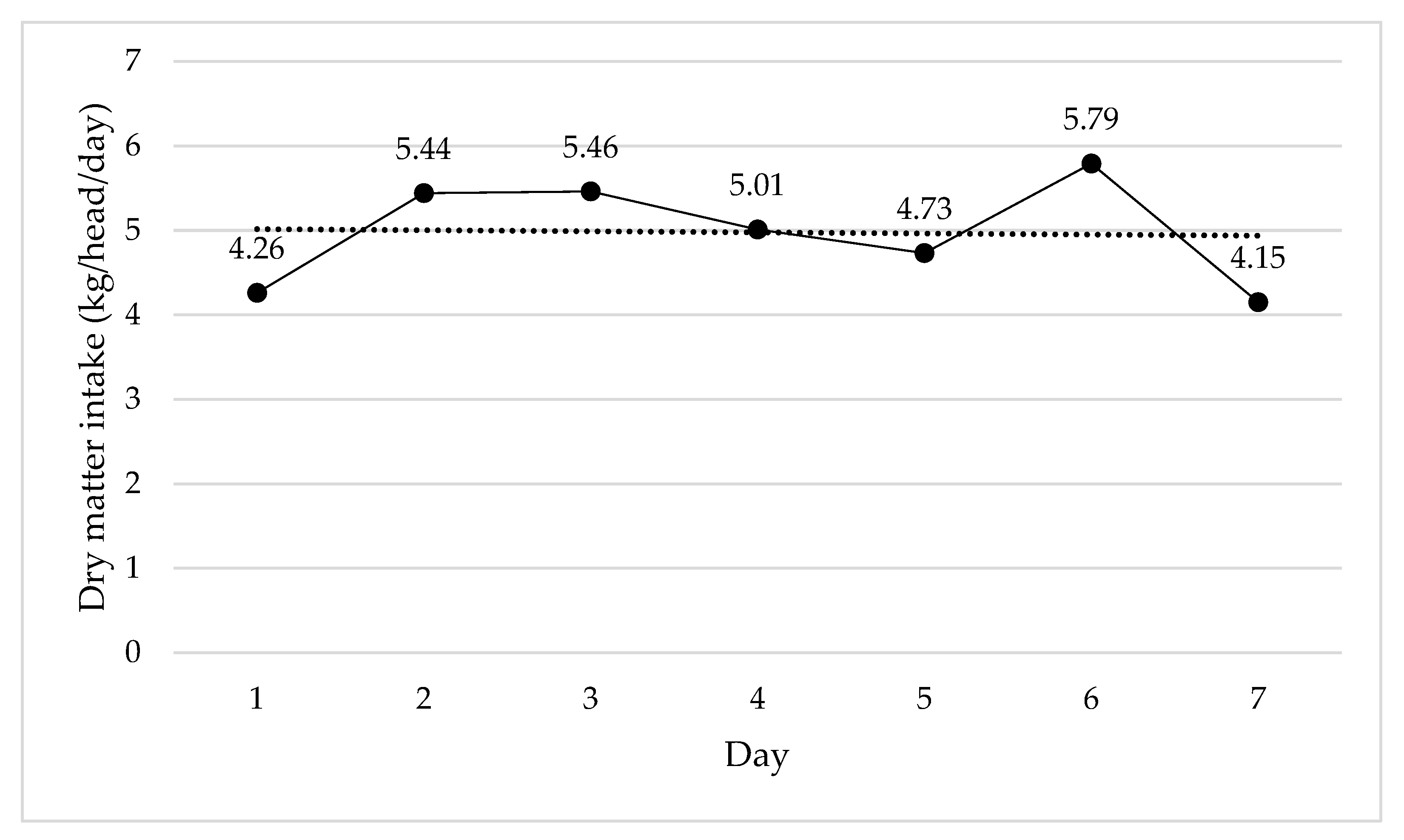

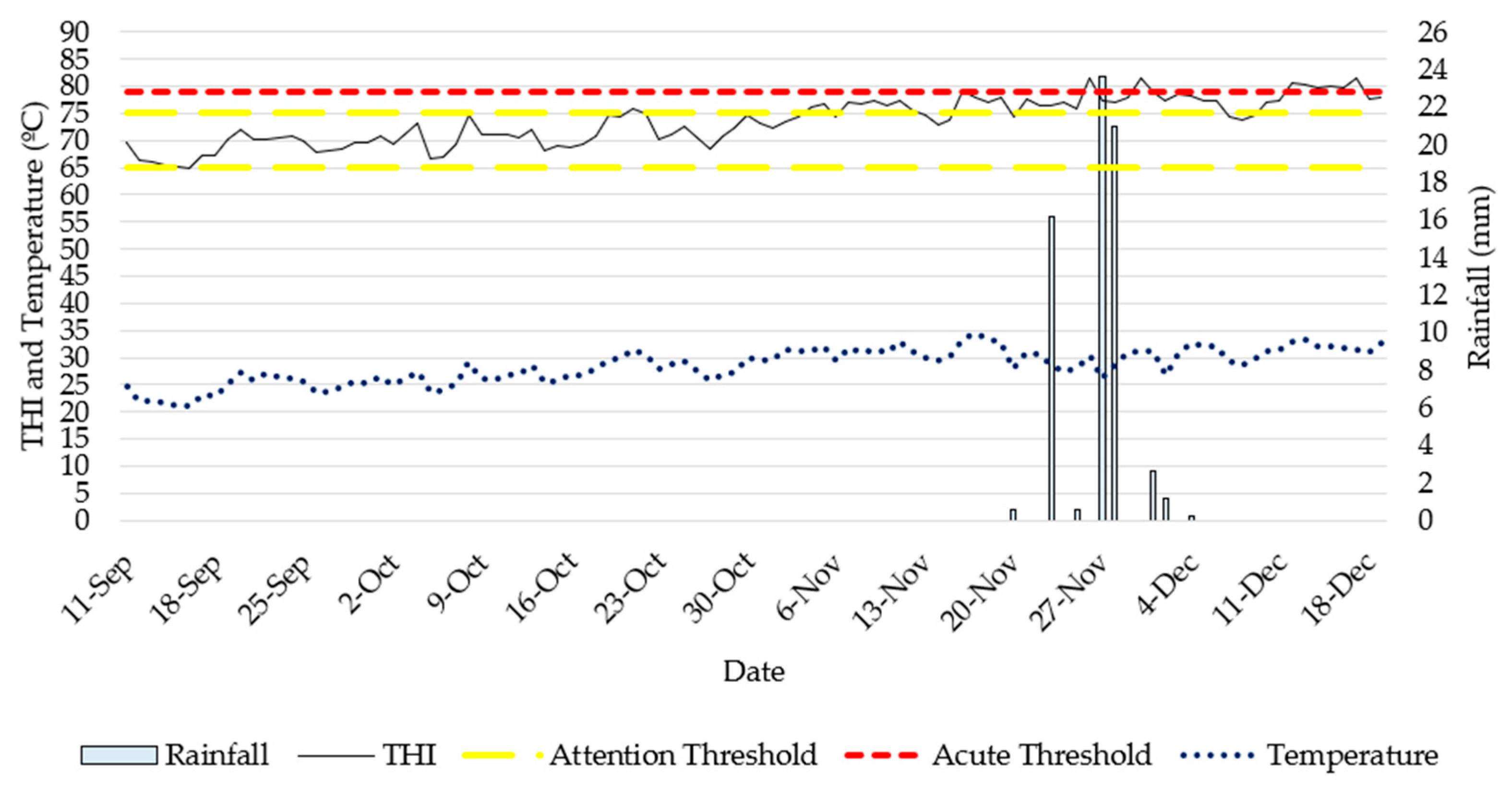

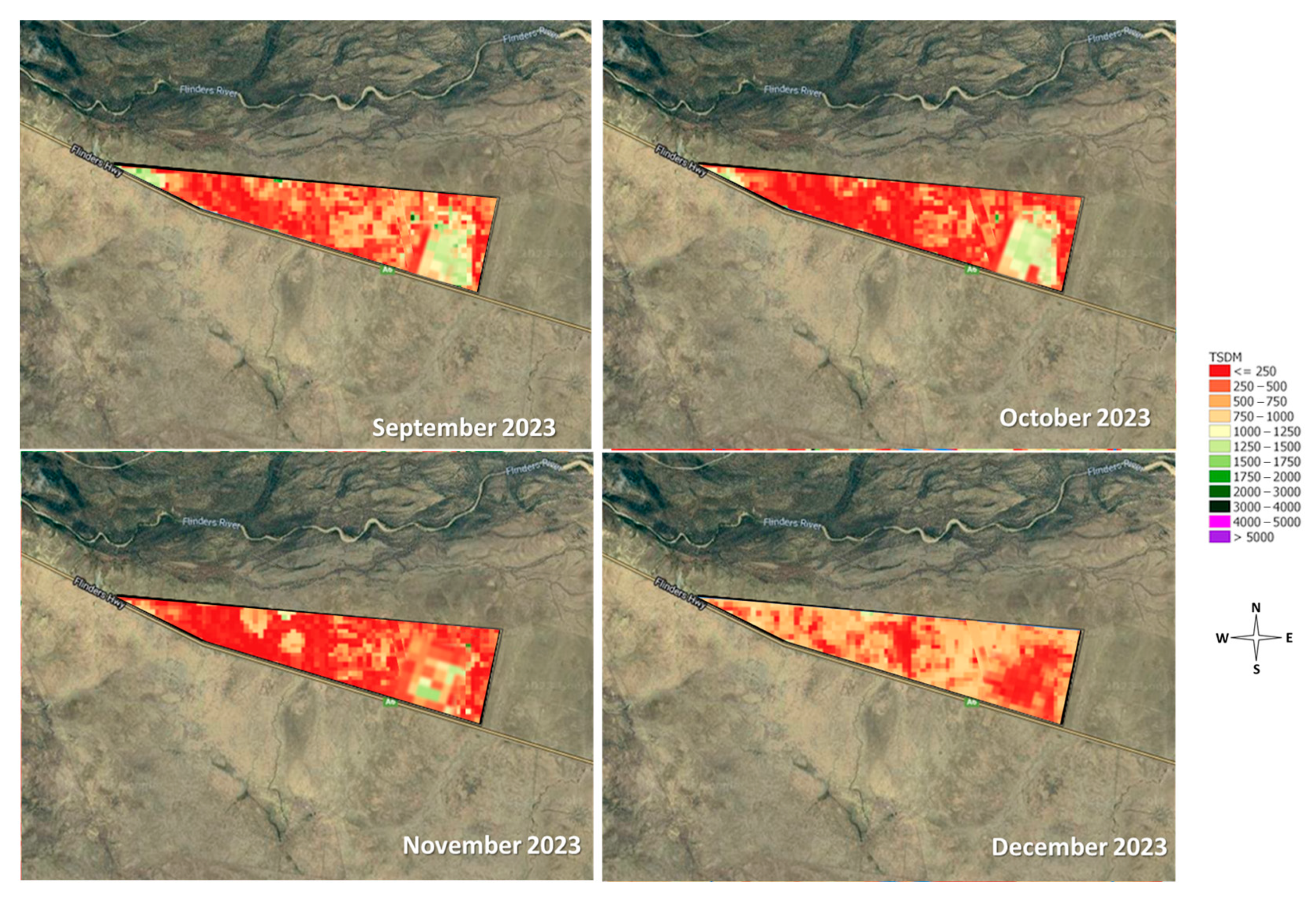
| Variable | Treatment | ||
|---|---|---|---|
| T1 | T2 | T3 | |
| Water (L) | 15.16 | 15.46 | 20.00 |
| uPRO ORANGE® 1 (L) | 4.54 | 4.54 | 0.00 |
| Agolin Ruminant L® 2 (mL) | 30.00 | 0.00 | 0.00 |
| Chemical composition (mg/L) | |||
| Nitrogen | 435.27 | 435.27 | 0.00 |
| Phosphorus | 94.05 | 94.05 | 0.00 |
| Sulphur | 26.40 | 26.40 | 0.00 |
| Agolin Ruminant L® | 0.015 | 0.00 | 0.00 |
| Variable | Treatment 1 | |||
|---|---|---|---|---|
| RD | HD | NC | PC | |
| Water (L) | 400.00 | 400.00 | - | - |
| uPRO ORANGE HP® 2 (kg) | 600.00 | 600.00 | - | - |
| Chemical composition (mg/L) | ||||
| Nitrogen | 305.58 | 488.93 | - | - |
| Phosphorus | 87.08 | 139.33 | - | - |
| Sulphur | 20.00 | 32.00 | - | - |
| Variable | Treatment 1 | ||
|---|---|---|---|
| T1 | T2 | T3 | |
| pH | 3.16 | 3.36 | 6.26 |
| TDS 2 (ppm) | 640 | 568 | 196 |
| Hardness Calcium (ppm) | 0.81 | 0.72 | 0.85 |
| Hardness Magnesium (ppm) | 0.33 | 0.34 | 0.34 |
| Variable | Treatment 1 | SEM 2 | p-Value | ||
|---|---|---|---|---|---|
| T1 | T2 | T3 | |||
| Total water intake (L/head) | 31.4 | 35.0 | 29.1 | 2.12 | 0.67 |
| Total time spent drinking (min/head) | 13.4 | 14.2 | 11.0 | 1.28 | 0.57 |
| Water intake ratio (L/min) | 2.9 | 3.2 | 3.2 | 0.18 | 0.90 |
| Variable | Treatment 1 | |||
|---|---|---|---|---|
| RD | HD | NC | PC | |
| Experimental Period 1 (11 September until 5 October 2023) | ||||
| pH | - | - | 7.75 | 7.59 * |
| TDS 2 (ppm) | - | - | 331 | 309 * |
| Hardness Calcium (ppm) | - | - | 1.06 | 0.55 * |
| Hardness Magnesium (ppm) | - | - | 0.56 | 0.57 * |
| Experimental Period 2 (6 until 30 October 2023) | ||||
| pH | 7.57 | 7.31 | 8.35 | 7.78 ᵼ |
| TDS 2 (ppm) | 693 | 302 | 239 | 443 ᵼ |
| Hardness Calcium (ppm) | 0.67 | 0.71 | 0.74 | 0.77 |
| Hardness Magnesium (ppm) | 0.44 | 0.45 | 0.54 | 0.66 |
| Experimental Period 3 (31 October until 24 November 2023) | ||||
| pH | 8.26 | 8.38 | - | - |
| TDS 2 (ppm) | 472 | 499 | - | - |
| Hardness Calcium (ppm) | 0.66 | 0.47 | - | - |
| Hardness Magnesium (ppm) | 0.42 | 0.38 | - | - |
| Experimental Period 4 (25 November until 19 December 2023) | ||||
| pH | 8.13 | 8.37 | 7.97 | 8.52 |
| TDS 2 (ppm) | 487 | 439 | 342 | 357 |
| Hardness Calcium (ppm) | 0.80 | 0.75 | 0.71 | 0.75 |
| Hardness Magnesium (ppm) | 0.69 | 0.58 | 0.51 | 0.59 |
| Exp. Per 1 | Treatment 2 | Total | SEM 3 | p-Value 4 | |||
|---|---|---|---|---|---|---|---|
| RD | HD | NC | PC | ||||
| 1 | 1584 a | 408 b | 1944 A | 146.6 | <0.0001 | ||
| 2 | 73 b | 85 b | 734 a | 659 a | 1502 AB | 57.4 | <0.0001 |
| 3 | 823 a | 142 b | 1021 B | 75.2 | <0.0001 | ||
| 4 | 219 | 0 | 154 | 197 | 570 C | 25.2 | 0.07 |
| SEM 3 | 90.0 | ||||||
| p-Value 5 | <0.0001 | ||||||
Disclaimer/Publisher’s Note: The statements, opinions and data contained in all publications are solely those of the individual author(s) and contributor(s) and not of MDPI and/or the editor(s). MDPI and/or the editor(s) disclaim responsibility for any injury to people or property resulting from any ideas, methods, instructions or products referred to in the content. |
© 2024 by the authors. Licensee MDPI, Basel, Switzerland. This article is an open access article distributed under the terms and conditions of the Creative Commons Attribution (CC BY) license (https://creativecommons.org/licenses/by/4.0/).
Share and Cite
Romanzini, E.P.; McCollum, V.; Mcilveen, S.; da Silva, K.D.; de Souza, W.L.; Bernardes, P.A.; Costa, D.F.A. Drinking Behaviour of Beef Cattle Subject to Water Medication in Various Environmental Conditions. Ruminants 2024, 4, 213-226. https://doi.org/10.3390/ruminants4020015
Romanzini EP, McCollum V, Mcilveen S, da Silva KD, de Souza WL, Bernardes PA, Costa DFA. Drinking Behaviour of Beef Cattle Subject to Water Medication in Various Environmental Conditions. Ruminants. 2024; 4(2):213-226. https://doi.org/10.3390/ruminants4020015
Chicago/Turabian StyleRomanzini, Eliéder Prates, Vivienne McCollum, Sarah Mcilveen, Kawane Dias da Silva, William Luiz de Souza, Priscila Arrigucci Bernardes, and Diogo Fleury Azevedo Costa. 2024. "Drinking Behaviour of Beef Cattle Subject to Water Medication in Various Environmental Conditions" Ruminants 4, no. 2: 213-226. https://doi.org/10.3390/ruminants4020015
APA StyleRomanzini, E. P., McCollum, V., Mcilveen, S., da Silva, K. D., de Souza, W. L., Bernardes, P. A., & Costa, D. F. A. (2024). Drinking Behaviour of Beef Cattle Subject to Water Medication in Various Environmental Conditions. Ruminants, 4(2), 213-226. https://doi.org/10.3390/ruminants4020015








